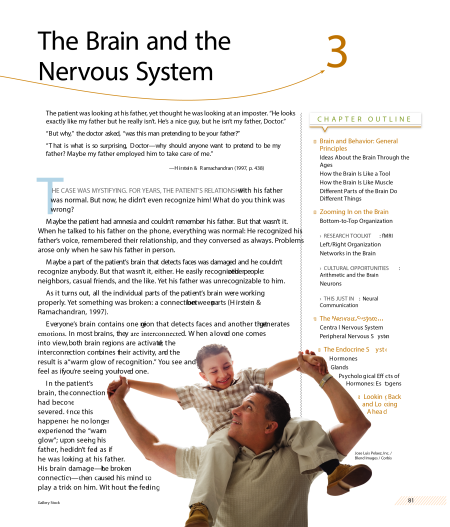Chapter 3. The Brain and the Nervous System
3.1 Introduction


3.2 Slide 2
Welcome to your Try This! research experience for Chapter 3. As you learned when reading the chapter, this experience consists of a mental activity that illustrates the close connection between mind and brain.
Before proceeding, try a brief thought experiment. Close your eyes and form an image of a pair of eyeglasses. Imagine that they are facing you, but that they start rotating to the right 90 degrees, so that the right is of the glasses are now facing you.
Researchers refer to this task as mental rotation. Was it easy for you?
Researchers Lynn Cooper and Roger Shepard asked research participants to mentally rotate simple images. See if you can mentally rotate the stimuli they used.
3.3 Slide 3
How well would you perform on a task involving mental rotation? We're about to find out. The following experiment simulates a classic mental rotation experiment, with you as the participant! This experiment is designed to measure how long it takes people to make decisions about rotated letters. On each of the 36 trials you will see a letter “R” in a circle. This letter will be shown to you in various orientations.

On half the trials, you will see a normal letter - that is, a letter “R” that has been rotated but not flipped.



On the other half of the trials, you will see a backward letter - that is, a letter “R” that has been flipped so that it is a mirror image of a normal “R.”



You must decide whether each letter is “normal” or “backward.” If the letter is “normal,” press the “normal” button on the screen (or “n” keyboard shortcut). If the letter is “backward,” press the “backward” button on the screen (or “b” keyboard shortcut). Your reaction time will be tracked and recorded. After completing the experiment you may proceed to the next section or do the experiment over.
3.4 Slide 4
3.5 Slide 5
The table shows your reaction time at each orientation for the normal letters and the backward letters.
| RT | 0 | 60 | 120 | 180 | 240 | 300 |
|---|---|---|---|---|---|---|
| Normal | ||||||
| Backward | ||||||
| Combined |
This graph shows (in red) your reaction time results compared to (in blue) results from a very similar experiment conducted by Cooper and Shepard (1973).
3.6 Slide 6
As you just saw, if your responses were like most people’s, your reaction time got slower the closer the rotation of the letter R was to 180 degrees, or upside down:
Your decision making was likely faster when the rotation was just, say, 60 degrees:
Take a moment to consider why before you return to the main text for an explanation. There, you’ll also learn how this mind-level activity is connected to activity at the brain level.
Check the results on the previous slide.
This activity is based on and inspired by:
Cooper, L. A., & Shepard, R. N. (1973). The time required to prepare for a rotated stimulus. Memory & Cognition, 1, 246-250.